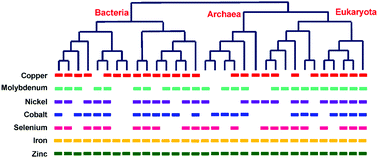Comparative genomics and metagenomics of the metallomes
Abstract
Biological trace metals are needed by all living organisms in very small quantities. They play important roles in a variety of key cellular processes, resulting in a varying degree of dependence on metals for different organisms. While most effort has been placed on identifying metal metabolic pathways and characterizing metalloproteins and their functions, computational and systematical analyses of the metallomes (or metalloproteomes) have been limited. In the past several years, comparative genomics of the metallomes has arisen, which provides significant insights into the metabolism and function of metals as well as their evolution. This review focuses on recent progress in comparative genomic analysis of trace metals (such as copper, molybdenum, nickel, cobalt, selenium, iron and zinc) in both prokaryotes and eukaryotes. These studies reveal distinct and dynamic evolutionary patterns of the utilization of different metals and metalloproteins. We also discuss advances in comparative metagenomic analysis of metals in microbial communities in diverse environments such as the global marine ecosystem, which offer new clues to the relationship between metal utilization and different types of environmental factors. Overall, comparative genomic and metagenomic analyses of the metallomes provide a foundation for systematic understanding of metal utilization, function and related evolutionary trends in the three domains of life.

- This article is part of the themed collection: Recent Review Articles


 Please wait while we load your content...
Please wait while we load your content...